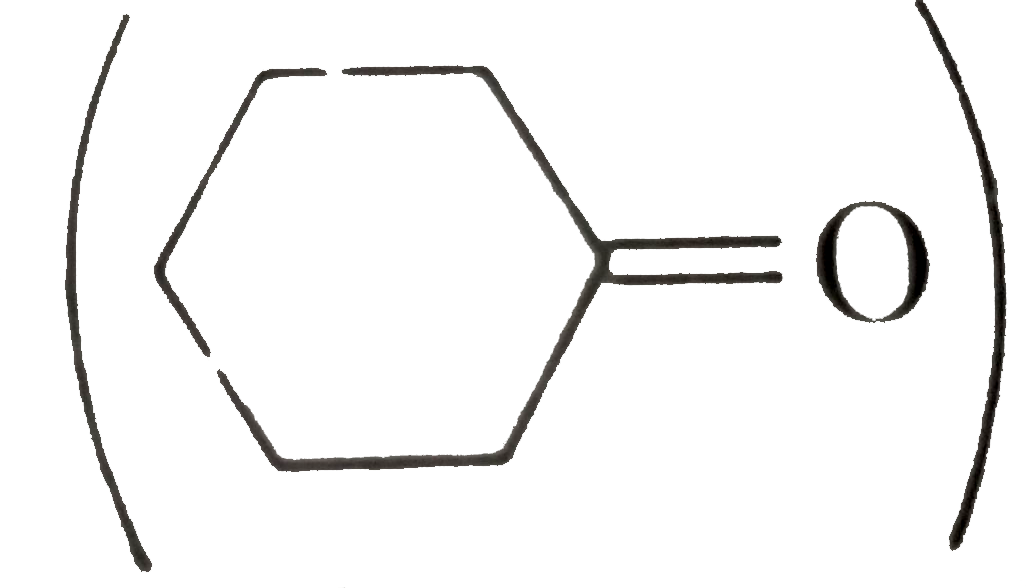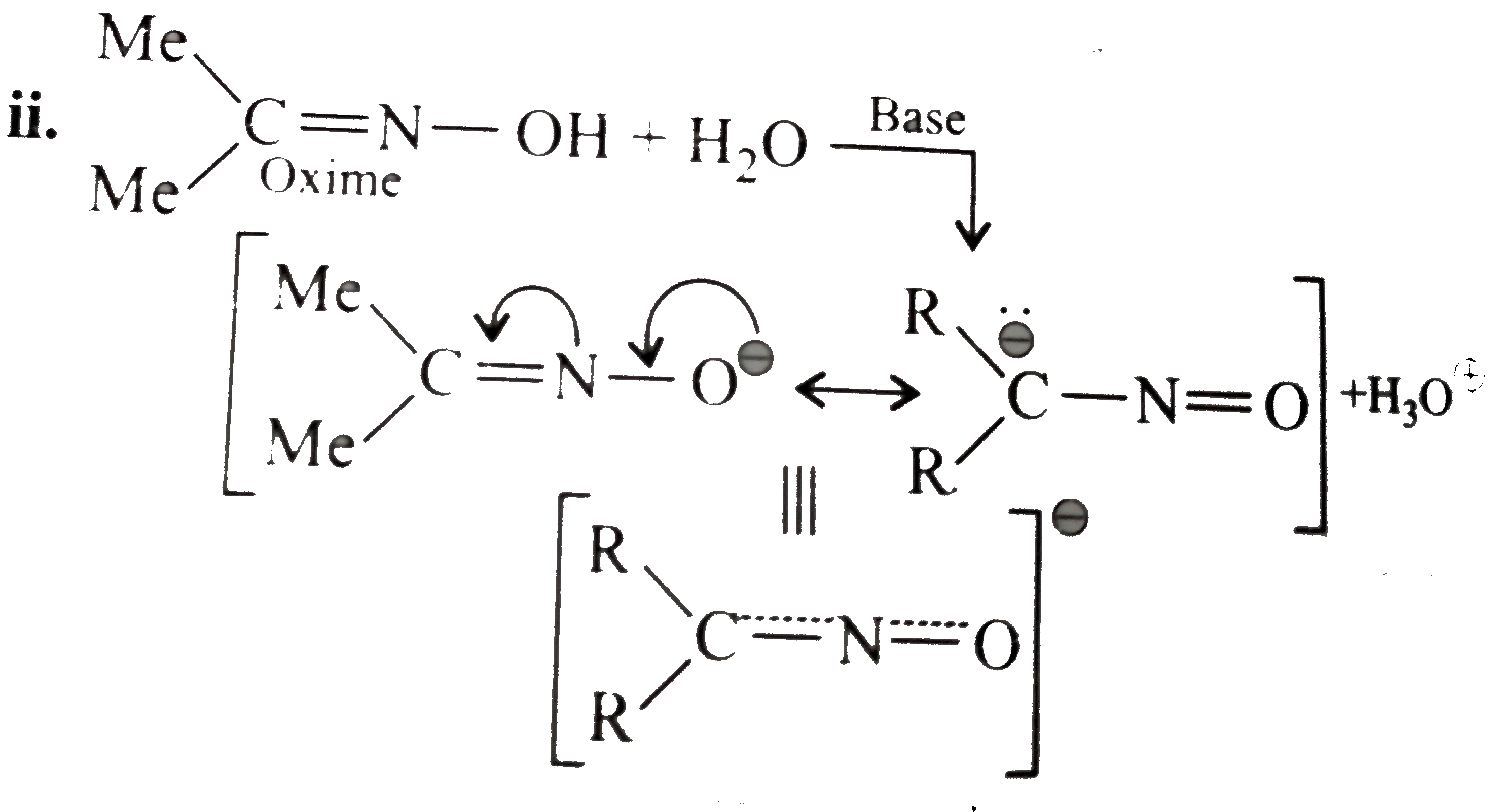Explain:
a. Oxime are more acidic than hydroxylamine.
b. when 1 mol of  and 1 mol of (PhCH=O), after standing for a few hours, the only procut formed is benzaldehyde semicarbazone.
and 1 mol of (PhCH=O), after standing for a few hours, the only procut formed is benzaldehyde semicarbazone.
c. In the conversion of

by using Grignard reagent of 
(I), why (C=O) group is protected?
a. i. 
Loss of H⊕ from NH2OH gives cojugate base NH2OΘ is not stabilised, so the reaction is reversible.
ii. 
The negative charge on the conjugate base if oxime is resonance stabilised by the delocalisation of negative charge by extended π− bond, as shown above. So the reaction is irreversible. Hence, R2C=N−OΘ is a weaker base and its conjugate acid, the oxime (R2C=N−OH) is more acidic.
Thus, oximes are more acidic than hydroxylamine.
b. i. 
ii. 
In cyclohexanone (A),(C=O) group is not sterically hindered because its R groups are tied back into a ring, so kinetically controlled product (I) is formed first.
Formation of (II) takes place slowly because (C=O) group is deactivated by ¯e−donating (+R effect) of (Ph) group. But (II) is more stable product due to the conjugation of double of (Ph) group with the double bond of (CH=N)

So the formation of product (II) is thermodynamically controlled. In such competitive reversible reaction, the equilibrium shifts with time to the more stable product (II).
c. If (C=O) group in the compound (I) is not protected, the G.R. of (I)  will react with the (C=O) group in other molecule as it forms. So, before making G.R. of (I),(C=O) group is protected by cyclic acetal formation.
will react with the (C=O) group in other molecule as it forms. So, before making G.R. of (I),(C=O) group is protected by cyclic acetal formation.

Topper's Solved these Questions
- ALIPHATIC AND AROMATIC ALDEHYDES AND KETONESBOOK - CENGAGE CHEMISTRYCHAPTER - ALIPHATIC AND AROMATIC ALDEHYDES AND KETONESEXERCISE - Solved Examples
13 Videos
- ALIPHATIC AND AROMATIC ALDEHYDES AND KETONESBOOK - CENGAGE CHEMISTRYCHAPTER - ALIPHATIC AND AROMATIC ALDEHYDES AND KETONESEXERCISE - Exercises Subjective
52 Videos
- ALCOHOL,PHENOL AND ETHERSBOOK - CENGAGE CHEMISTRYCHAPTER - ALCOHOL,PHENOL AND ETHERSEXERCISE - Archives Analytical And Descriptive
15 Videos
- AMINESBOOK - CENGAGE CHEMISTRYCHAPTER - AMINESEXERCISE - QUESTION BANK
1 Videos
Similar Questions
The reactions of hydroxylamine with a symmetrical ketone (R2C=O) froms only one oxmie. However two isomeric oximes may be formed when an aldehyde or non-symmetical ketone takes part in the reaction. Explain.
View SolutionA 2.0 L container at 25∘C contain 1.25 mol of O2 and 3.2 mol of C.
(a) What is the initial pressure in the flask ?
(b) If the carbon and oxygen react as completely as possible to form CO, what will be the final pressure in the container?
View Solution
Knowledge Check
Grignard reagents (RMgX) are prepared by the reaction of an organic halide and magnesium metal in ether solvent.
R−X+MgR−OR−−−→R−MgX
The solvent (usually diethyl ether or tetrahydrofuran) plays a crucial role in the formation of a Grignard reagent. Alkyl halides are more reactive than art and vinyt halides, Indeed, aryl and vinyl halides. Indeed aryl and vinyl chlorides do not form Grignard reagents in dethyf other. However, an att ha de containing an alcoholic - OH group can be converted to Grignard reagent by graf protecting the - OH group to a tert-butytdimethytslyt ether which is not to Grignard reagent. The protecting group is finally liberated by treatment with lotion
R−O−H+Cl−CH3∣Si∣CH3Tert-Butylchlorodimethyilance−C(CH3)3→R−O−Si−CH3∣C∣CH3(CH3)3(C4H9)N+F−−−−−−−−−−→R−O−H+F−Si−CH3∣C∣CH3(CH3)3
The function of tetrahydrofuran in the preparation of Grignard reagent is that itAacts as a solventBhelps in maintaining the reaclivity of magnesiumCbothDnone of the aboveGrignard reagents (RMgX) are prepared by the reaction of an organic halide and magnesium metal in ether solvent.
R−X+MgR−OR−−−→R−MgX
The solvent (usually diethyl ether or tetrahydrofuran) plays a crucial role in the formation of a Grignard reagent. Alkyl halides are more reactive than art and vinyt halides, Indeed, aryl and vinyl halides. Indeed aryl and vinyl chlorides do not form Grignard reagents in dethyf other. However, an att ha de containing an alcoholic - OH group can be converted to Grignard reagent by graf protecting the - OH group to a tert-butytdimethytslyt ether which is not to Grignard reagent. The protecting group is finally liberated by treatment with lotion
R−O−H+Cl−CH3∣Si∣CH3Tert-Butylchlorodimethyilance−C(CH3)3→R−O−Si−CH3∣C∣CH3(CH3)3(C4H9)N+F−−−−−−−−−−→R−O−H+F−Si−CH3∣C∣CH3(CH3)3
H2N(CH2)3Br can't be converted into corresponding Grignard reagent becauseAreaction between −NH2andBr group present in the same moleculeBof strong nucleophilic character of the Grignard reagentCof strong basic nuture of the Grignard reagentDall of the aboveGrignard reagents (RMgX) are prepared by the reaction of an organic halide and magnesium metal in ether solvent.
R−X+MgR−OR−−−→R−MgX
The solvent (usually diethyl ether or tetrahydrofuran) plays a crucial role in the formation of a Grignard reagent. Alkyl halides are more reactive than art and vinyt halides, Indeed, aryl and vinyl halides. Indeed aryl and vinyl chlorides do not form Grignard reagents in dethyf other. However, an att ha de containing an alcoholic - OH group can be converted to Grignard reagent by graf protecting the - OH group to a tert-butytdimethytslyt ether which is not to Grignard reagent. The protecting group is finally liberated by treatment with lotion
R−O−H+Cl−CH3∣Si∣CH3Tert-Butylchlorodimethyilance−C(CH3)3→R−O−Si−CH3∣C∣CH3(CH3)3(C4H9)N+F−−−−−−−−−−→R−O−H+F−Si−CH3∣C∣CH3(CH3)3
Grignard reagent can't be prepared fromA B
B C
C D
D
(a) Give a plausible expianation for each one of the following : -
(i) There are two - NH2 groupsin semicarbazide. However, only one such group is involvedin the formation of semicarbazones.
(ii) Cyclohexanone forms cyanohydrin in good yield but 2,4,6-trimethylcyclohexanone does not.
(b) An organic compound with molecular formulaC9H10O forms, 2,4- DNP derivative, reduces Tollens' reagent and undergoes Cannizzaro reaction.
On vigorous oxidation it gives 1,2-benzene-di-carboxylic acid. Identify the compound.
View SolutionGrignard reagents (RMgX) are prepared by the reaction of an organic halide and magnesium metal in ether solvent.
R−X+MgR−OR−−−→R−MgX
The solvent (usually diethyl ether or tetrahydrofuran) plays a crucial role in the formation of a Grignard reagent. Alkyl halides are more reactive than art and vinyt halides, Indeed, aryl and vinyl halides. Indeed aryl and vinyl chlorides do not form Grignard reagents in dethyf other. However, an att ha de containing an alcoholic - OH group can be converted to Grignard reagent by graf protecting the - OH group to a tert-butytdimethytslyt ether which is not to Grignard reagent. The protecting group is finally liberated by treatment with lotion
R−O−H+Cl−CH3∣Si∣CH3Tert-Butylchlorodimethyilance−C(CH3)3→R−O−Si−CH3∣C∣CH3(CH3)3(C4H9)N+F−−−−−−−−−−→R−O−H+F−Si−CH3∣C∣CH3(CH3)3
Griganrd reactions generally occur in dry ether because
View SolutionGrignard reagent is usually prepared by
R−X+MgEt2O−−→RMgX Grignard reagent
Ar−X+MgEt2O−−→ArMgX Grignard reagent
Grignard reagent acts s a strong base. Grignard reagent carry out nucleoplilic attack in absence of acidic hydrogen. Grignard reagent form complex with its ether solvent. Complex formation with molecule of ether is an important factor in the formation and stability of Grignard reagent.
Cl−O∣∣C−O−Et(1)xRMgX−−−−−−−→(2)NH4Cl3∘ alcohol. Value of x is :
View SolutionGrignard reagent is usually prepared by
R−X+MgEt2O−−→RMgX Grignard reagent
Ar−X+MgEt2O−−→ArMgX Grignard reagent
Grignard reagent acts s a strong base. Grignard reagent carry out nucleoplilic attack in absence of acidic hydrogen. Grignard reagent form complex with its ether solvent. Complex formation with molecule of ether is an important factor in the formation and stability of Grignard reagent.
H−O−CH2−CH2−O∣∣C−O−Et(1)xPhMgBr−−−−−−−−→(2)H+HO−CH2−CH2−OH∣C∣Ph−Ph, Value of x is :
View SolutionDialkyl ethers react with very few reagents other acids. The only reactive sites that molecules of a dialkyl ether has to another reactive substance are the C H bonds of the alkyl groups and the O group of the ether linkage. Heating dialkyl ethers with very strong acids. (HI,HBr,andH2SO4) causes them to undergo reactions in which the carbon-oxygen bond breaks. When mixed ethers are used, the alcohol and alkyl iodide that form depend on the nature of the alkyl groups. Mechanism is by S2N reaction or S1N.

B gives positive lucas test in a few seconds. Which is 'B'.
View Solution
